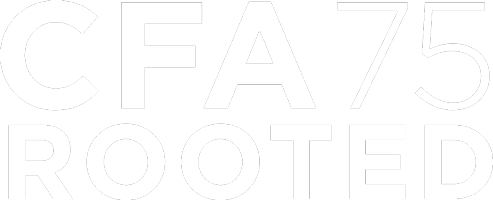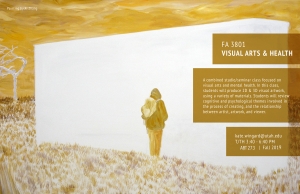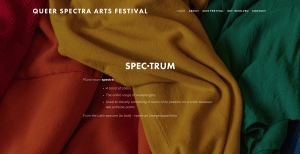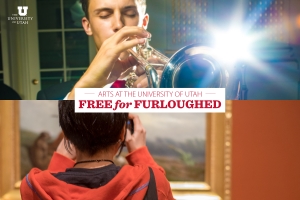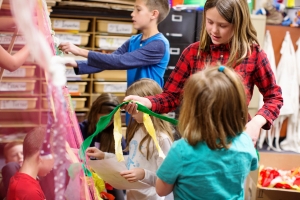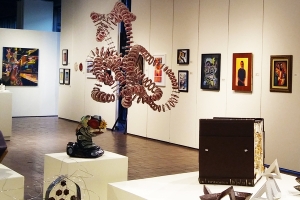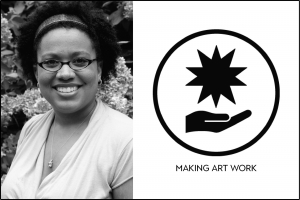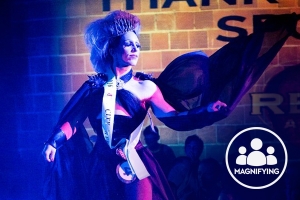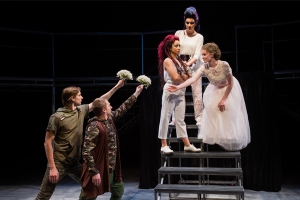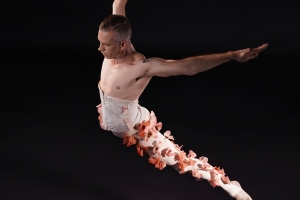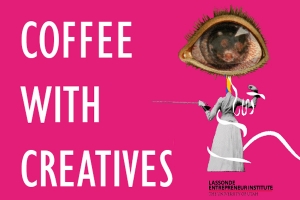Displaying items by tag: Art
by Anna Oldroyd
Kathryn Wingard is a ceramics MFA candidate within the department of Art & Art History as well as a licensed mental health counselor and registered art therapist within the U of U hospital system. This fall, Kathryn Wingard will again be teaching her special topics course, FA 3801 “Visual Arts & Health.” The course offers a unique intersection of visual arts and mental health.
In this combined studio/seminar class, students will be introduced to concepts related to cognitive and psychological elements. These concepts engage the visual arts, with a recurrent subtheme of relationships and empathy. The class will cover the idea of art making and viewing as (potentially) empathetic experiences involving relationships. These relationships include the artist’s relationship with artwork, the viewer’s relationship with the art, and the viewer/artist relationship.
Student Emily Comstock said “Kate’s Visual Arts and Health class was a consciousness-expanding and productively complex course that transformed my thinking about responding to art, art-making, and the nature of my own artistic practice. My experience was defined by a highly supportive and dynamic environment which integrated the very concepts of thinking and engaging with what we learned about.”
Students will produce 2D and 3D art with a variety of materials. They will review cognitive and psychological themes involved in the process of creating, such as the flux between order and chaos, gestalt, goal attainment, conflict resolution, problem solving, distress tolerance, and interpersonal effectiveness. They will also cover theories about the use of art as coping and art as confrontation. Concepts related to art as a mindfulness tool will be introduced to the artist and the viewer, as well as the somatic, visceral experience of engaging with art.
“This course has been my absolute favorite class,” said Eden Merkley, who was enrolled in last year’s Visual Arts & Health class. “Kate is incredibly student-centered and the material that we cover is interesting since it is widely applicable in the outside world; both personally and as an artist. It taught me how to have an open dialogue with artworks, and to value/see the importance of materials. This has helped me grow as an artist as I'm able to explore my intention for creating pieces.”
The course is open to all students, with or without fine art experience.
Course Catalogue: FA 3801 Special Topics in the Fine Arts; #15546, Sec 001: Visual Arts & Health
Date and Time: T/TH from 3:40-6:40 PM
Room: ART 273
Credits: 3 elective credits (unless approved for substitution of curriculum requirements)
Salt Lake is about to embark on a new festival experience, one that is very much needed and dually important. Queer Spectra Arts Festival, in its first year, is dedicated to showcasing arts from multiple LGBTQIA+ perspectives. The festival began as the 2-year brain child of Dat Nguyen, an alum of the College of Fine Arts School of Dance. Nguyen had been involved in numerous underground art scenes in Salt Lake City that featured some queer-focused art but he felt there could be another venue to showcase queer art.
He saw the need for a space and he began to dream.
The festival became a reality with the help and passion of U alumni Emma Sargent (BFA in Modern Dance and a BA in Gender Studies), Aileen Norris (Honors BFA in Modern Dance and BA in English) and Molly Barnewitz (MA in Comparative Literary and Cultural Studies), who joined Nguyen in creating what is now called “Queer Spectra Arts Festival”.
As curators, they aim to present a diverse array of voices, backgrounds, experiences, cultures, mediums, and artistic disciplines in order to celebrate queer artistic expressions. Their hopes are to challenge and contribute to contemporary understanding of queer discourse while promoting a nuanced conversation between artists and audiences about queer identity and art.
“In the dance world there is a lot of queer dance performance going on but it seems to be heteronormative, and queer performance art is treated as niche — an underground thing,” Sargent said. “There’s art makin going on but not a lot of discourse. Art pieces I have been a part of have been insularly produced, everyone involved in the process will be queer and cathartic but there isn’t a platform for queer dance to be seen as other types art. Salt Lake City is also a great place for modern dance and ballet, but a lot of the dance that is funded is perhaps more traditional or classical. Issues of art projects that get funding are sort of apolitical, easier to get it funded. Queer art is often being perceived as being political. It hasn’t reached a cultural moment of being depolitized.”
Emma Sargent speaks about one of the festival’s goals being “to increase opportunities for queer folks. We are creating another artist space that includes artists in many different points in their careers, not just highlighting established artists, name recognition and experience. It’s a good mix of people who are still in school and recently graduated”
It’s clear these four are not just creating a physical space for queer artists to show their work and be represented, but to also engage in a dialogue around the journey of being a queer artist and the works that can come from those lived experiences.
“A journey as a queer person and a journey as an artist is really hard,” Nguyen said as advice to current students. “Learn to love yourself and learn to be in touch with yourself and your art. Don’t just let your identify inform your art, be open minded, let your art inform your identify. Let the art create the artist. Come in and create chaos, let the chaos inform you”.
With 29 artists participating in the festival, it’s clearly more than an art event but an important conversation catalyst for queer artists in Salt Lake City.
For more information on these artists, please visit the Queer Spectra website.
2019 FESTIVAL DETAILS
5/25 from 1P -10P at the Commonwealth Studios (150 W. Commonwealth Ave)
TENTATIVE SCHEDULE
1P Welcome & Opening Remarks - 2D and 3D Gallery Opens
1P - 1:30P Keynote: Well, Is It? Questioning What Makes Art Queer
2P - 3P Workshop I: Details TBD
30 Time-based arts Presentation I, followed by Q&A
5:30-6:45P Workshop II: Embodied Imaginations
7:30P Time-based arts Presentation II, followed by Q&A
Learn more about the 2019 Queer Spectra artists here.
Arts at the U: Free for furloughed
By Marina Gomberg
During good times and bad, many turn to the arts for solace, inspiration, levity, and hope. That’s why, during this extended government shutdown, the arts entities at the University of Utah are offering furloughed federal employees free access to the arts on campus for the duration of the shutdown.
“As a community of artists, we recognize and appreciate our important role in supporting our communities and meeting them where they are,” said John W. Scheib, Ph.D., Associate Vice President for the Arts at the U and Dean of the College of Fine Arts. “We hope that in our theatres, halls and galleries, our proud friends can experience the joy and creativity the arts can so uniquely and powerfully provide.”
Below are the ways federal furloughed employees can enjoy arts experiences with us for free.
Pioneer Theatre Company
Pioneer Theatre Company is offering federal employees affected by the current government shutdown two free tickets to the three remaining performances of their current production, The Lion in Winter. Call (801-581-6961) or visit the Box Office (Open 10:00 a.m. – 6:00 p.m., Mon. – Fri.). Visit www.pioneertheatre.org for more information on the show. Employees who present a federal ID or federal pay stub at the box office window may receive up to two tickets for one of the remaining three performances. Quantity is limited; tickets are available on a first come, first served basis. We encourage picking up tickets ahead of time, if possible. This offer is not retroactive to previously purchased tickets.
School of Dance
The School of Dance is offering four free tickets to any upcoming performance during the shutdown. See the upcoming events list here. Then call 801-581-7100 or visit the Kingsbury Hall box office and identify yourself as a federal employee to receive your tickets.
School of Music
The School of Music is offering four free tickets to any upcoming performance during the shutdown. See the upcoming events list here. Then call 801-581-7100 or visit the Kingsbury Hall box office and identify yourself as a federal employee to receive your tickets.
Utah Museum of Fine Arts
The Utah Museum of Fine Arts (UMFA) is offering free admission to furloughed federal employees for the duration of the shutdown. Federal workers are asked to identify themselves at the UMFA welcome desk. For Museum hours, directions, and more information, please visit here.
UtahPresents
Four free tickets to all furloughed employees to any remaining performance on the UtahPresents season (excluding Banff Film Festival and At the Illusionist’s Table). See the upcoming events list here. Then call 801-581-7100 or visit the Kingsbury Hall box office and identify yourself as a federal employee to receive your tickets.
Inclusive Arts Spaces
By Kelby L McIntyre
Since 2016, I have had the honor to work in collaboration with Jonathan Hale, CFA alum and BTSALP visual art specialist, John McDonald, and Kristen Paul from the Department of Special Education to investigate effective inclusive arts spaces. In August of 2018, Jonathan and I were invited to present our observations in Atlanta, Georgia at the Kenney Center’s Very Special Arts (VSA) Intersections: Arts and Special Education Conference, a Jean Kennedy Smith Arts and Disability Program. Through innovative, thought-provoking, and interactive sessions, the VSA Intersections Conference provides professionals in the intersecting fields of arts education and special education the opportunity to share current information in research, practice, programs, and policy, and serve as a leading catalyst for change.
Our presentation shared glimpses of student successes, strategies for utilizing peer partners, art room configuration, and specific art experiences (e.g. group weaving) that supported the implementation of an inclusive art classroom at Sprucewood Elementary.In Atlanta, numerous K-20 educators from across the country informed us that they were eager to learn more about how to effectively use peer partners in various spaces.
Jonathan and I presented specific visual art lessons that were utilized in the study. The learning experiences embedded in each lesson implemented the least restrictive learning environment for all participants. The structure of the art activities provided students the space and freedom to adapt lessons and encouraged them to problem solve as a community. Our work so far has confirmed that successful art inclusive practices rely heavily on empowering, nurturing, and establishing clear peer partner roles.
Observations
1. Universally designed collaborative art lessons:
• When lessons were designed specifically as group projects or when individualized projects included structured opportunities for partner work, art inclusion seemed to be more successful.
• When movement throughout the room during the lesson was permitted and established as a norm for the lessons in the study, student interactions increased. This structure also supported students that needed to move throughout the room during the lesson.
• The art lessons seemed to be easily adaptable and provided social opportunities that helped foster relationships between typically developing students and their non-typically developing peers.
• Peer partners communicated acceptance of their non-typically developing peers through interviews and surveys.
2. Collaborative table groups:
• Non-typically developing students increased their sustained attention to tasks when working with peer partners.
• Over time, peer partners learned how to adapt activities and were able to effectively work in collaboration with non-typically developing students.
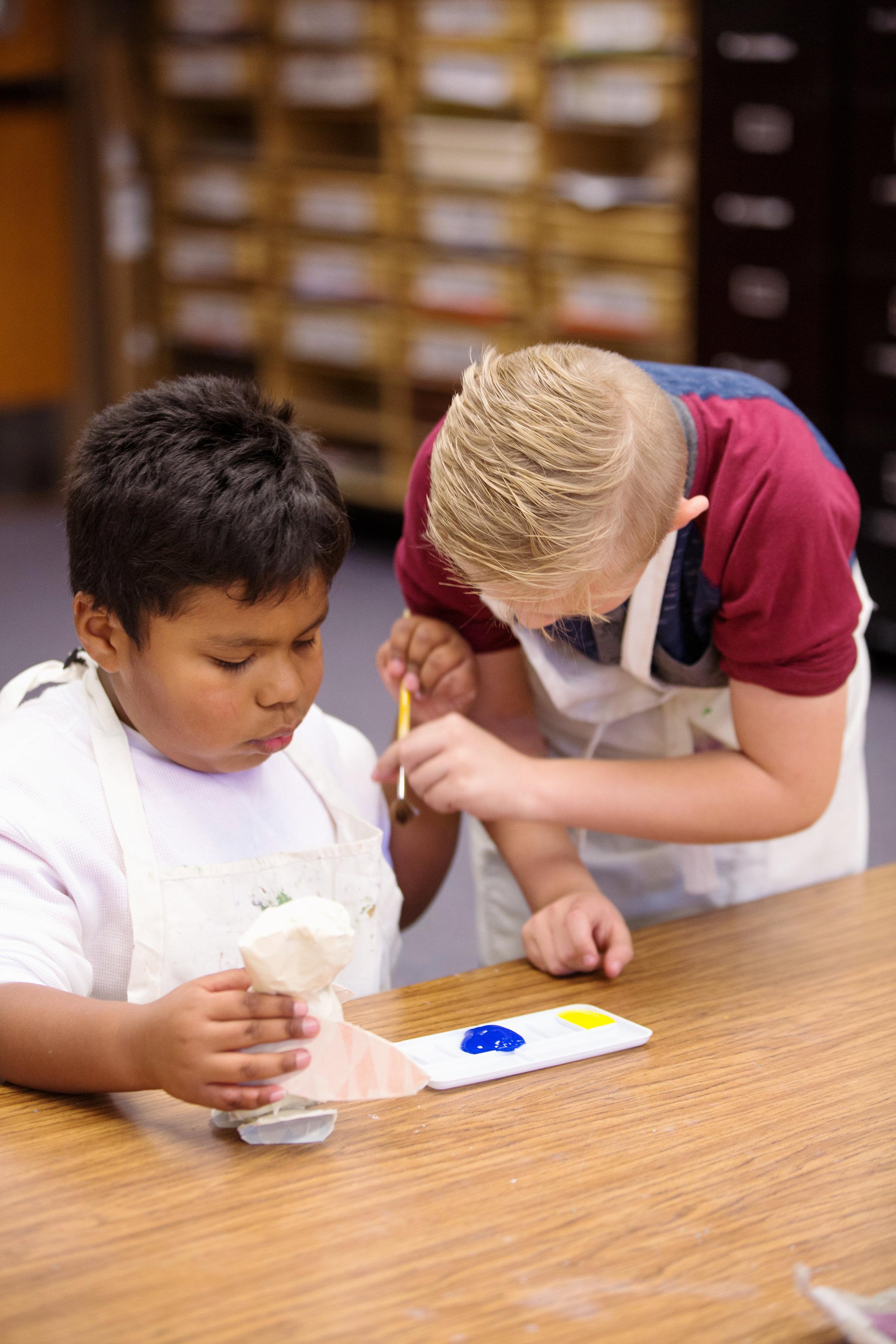
During our time in Atlanta, we were afforded valuable opportunities to engage in national conversations with arts educators and professors surrounding equity, access, and inclusive arts spaces. These connections have helped further inform our investigations as we include music, dance, and theatre in the study.
Post presentation, the Director of Humanities for the Orange County Department of Education invited us to share our work summer 2019. Participating in the VSA Conference challenged and inspired us to continue the exploration and advocacy of pedagogical approaches that improve educational experiences for all students. Learn more about the Kennedy Center.

2017 Annual Student Art Exhibition
By Guest Writer and Emerging Leaders Ambassador, Ashley Chin-Mark.
The Annual Student Art Exhibition (ASAE) has existed for as long as the Department of Art at the University of Utah. Although evolving since the very first exhibition, in which professors’ Alvin Gittins, Doug Snow, Dorothy Bearnson and Angelo Caravaglia were instrumental in fashioning the exhibition. Janine Evans, Executive Secretary and Graduate Assistant explained that the tradition of showcasing student works in the Gittins Gallery renamed after Alvin Gittins when he passed away in 1981 continues today. The 2017 gallery features 60+ works by 42+ artists with purchase values ranging from $50-$1000 each.
The Exhibition Faculty Advisor invites a different juror each year to bestow awards on select student pieces. Evans explains this process:“Initially, the Studio Art Faculty juried the exhibition but realized they were bias and perhaps letting in too many pieces of artwork. This year’s evaluator was the first student juror, Whitney Tasssie. As the Curator of Modern & Contemporary Art at the Utah Museum of Fine Arts, Tassie brought her extensive knowledge of art selection when judging this year’s entries.” Another exhibition tradition includes the selection of a single student work, by the Dean of the College of Fine Arts, which is then housed in the Dean’s Office. Students, faculty, employees, and visitors who have strolled through this area on the second floor may have noticed these large paintings hanging on the walls or the ceramic sculptures displayed near the entrance.
Another major difference in this year’s exhibition was the appointment of Emina Tatarevic to the role of the Art Student Liason. She is the first Art History student to assume this role. Tatarevic noted that “there is an unintentional degree of separation” that is built between the art emphases due to their distinct course paths. Luckily, as the Art Student Liason, the Undergrad Student Advisory Committee (SAC) Chair of Art & Art History, and an exhibition artist (her needlepoint work is on display in the exhibition), Emma Tatarevic submitted the FAF Grant to help cover the cost of the reception and the juror honorarium, which means she had a “hand in reaching out to the other Art students to facilitate a bit of change” to increase the frequency of interaction, cross-disciplinary awareness, and mutual appreciation across multiple areas of study. Tatarevic graciously explained, “This effort was a collaboration between all art emphases…we are so thankful to FAF Grants for supporting student initiated efforts. The overall experience between the faculty, staff, advisors, and students helps to enrich our time (as aspiring professional artists) here at the U.”
Indeed, the growth of the student artists is visible in the display of drawings, paintings, ceramics, sculptures, and photographs, and in noticing how they uniquely approached their individual subject matters. Art enthusiasts and gallery goers can expect to be exposed to stimulating and startling visuals that will change their perspective of art.
More events and ways to get involved:
Departmnet of Art and Art History
Gittins Gallery
Student Advisory Committee tudent Advisory Committee
@uofufinearts on Instagram and Facebook

MAKING ART WORK: Advice for artists, from artists is a series that taps into the knowledge and experience of seasoned creatives from our community and beyond for the benefit of our students. We ask three simple questions that get at the heart of what it takes to thrive.
For our first post we interviewed Assistant Professor in the Department of Theatre, Martine Kei Green-Rogers, PhD.
By Noelle Sharp
1. What do you wish you had known when you were a young artist?
That being an artist is a perfectly acceptable path for one's life, that being an artist is intellectually and emotionally stimulating, and that the work that I will do (and am capable of doing) has the potential to change someone's world view.
2. How do you find balance between creating your own art and using your creative talents for other projects (jobs, collaborations, etc.)?
I have yet to find that balance, unfortunately. I have a project that has been on the back burner for a while and will probably stay there for another couple of years. I just count myself lucky that I am in enough demand at the moment that I have to figure that out.
3. What’s the most useful advice you were given?
To pursue my joy! If a project or gig does not feel right in your soul -- don't do it. Life is too short to work at places that do not bring you joy.
Interested in contributing to this series? Contact Noelle Sharp.
MAGNIFYING, No.2: Shane Davis aka Janice Janice Janice
We spoke with School of Dance MFA graduate student and guest teacher Shane Davis, also known as Janice Janice Janice, about his evolution into dance, drag, teaching and self realizations about his true self.
By Noelle Sharp.
Tell us about yourself: Name, where you are from, what you do and how you got into in your field of work.
My name is Shane Davis. I also go by the performing name of Janice Janice Janice. I am most recently from Provo, Utah, where I attended Brigham Young University garnering a Bachelors of Arts in Modern Dance. I grew up near Seattle, WA, Houston, TX, and Albuquerque, NM.
What do I do?
Right now I am working on my MFA in modern dance and the graduate certificate in Gender Studies. I hope to be a choreographer for various venues, including music videos, Broadway and different dance troupes. Outside of academia, I perform as Janice Janice Janice around Salt Lake City. I have not become to proliferated in the Drag scene here in SLC but I hope to make my mark a little more pronounced in the coming months after graduation. I have been accepted as a performer at the Austin International Drag Festival which takes place in November. I am also currently teaching a course entitled "Dragging Gender into the 21st Century" that is a seminar type survey course that is part discussion of issues in and around Drag and part embodiment of the subject matter.
My sister Amanda, who is one of my best friends and mentor, encouraged me to go into both modern dance and Drag. I began my undergraduate career at BYU in the film program, but once one of my instructors said that my film art should primarily testify of Joseph Smith and Jesus Christ, I quit the program and drifted around for a couple of semesters. My older sister suggested that I take a modern dance class. I did and I fell in love. Years later, once I returned from an LDS mission and after coming out to Amanda as gay, she encouraged me to watch RuPaul's Drag Race. I got around to it and fell in love with that performance form and decided to try it out. I participated in the first (that we know of) Drag pageant in Utah county and won second place. I have since been involved with the scene here, and have won first place at the Miss City Weekly pageant that kicks off pride weekend each summer.
I decided to come to grad school after working a year in a dead end job after graduation with my undergraduate degree and I had a panic moment. That that job was not what I wanted to do with my life. I had more to learn. So I begged the director of the MFA program to allow me to audition (as I was a few months late) and the modern dance faculty granted me an audition and accepted me. I then also discovered the Graduate certificate in gender studies and decided to pursue that as I lacked sophisticated and critical thinking on the topics of sexuality and gender. I wanted to fill in holes of my understanding and to push my thinking.
What has surprised you the most in your life?
Uhf, that I'd be here of all places. Five years ago, I was still immersed in Mormonism and trying to adhere to their standards of compulsory daily drag. I had even gone back into the closet, telling my parents to disregard my previous coming out and that I was going to date women and make things work out in the path that they had chosen for me from the time the first ultrasound dubbed me a "boy." Now to see a crown and trophy hinting at my wins in a somewhat subversive art form, and also teaching a university course on Drag, is a tad surreal. I have traded in my missionary ties for high heels.
What do you wish you had known/been told?
I know this is kinda out of left field (what... a sports reference?), but I wish I had know or been told that I was not a freak and that I was ok to not be the same as the other "boys." I wish I had known that there were many ways to be a person in this world and to not have the yearning to put myself in a restrictive box. I wish I had come out at an earlier age and been stronger in my sense of self. I wish I had known about queer and feminist theories. Theorizing can be therapeutic and healing. I wish I had known that it was ok to experiment, ok to be fluid, and ok to fail.
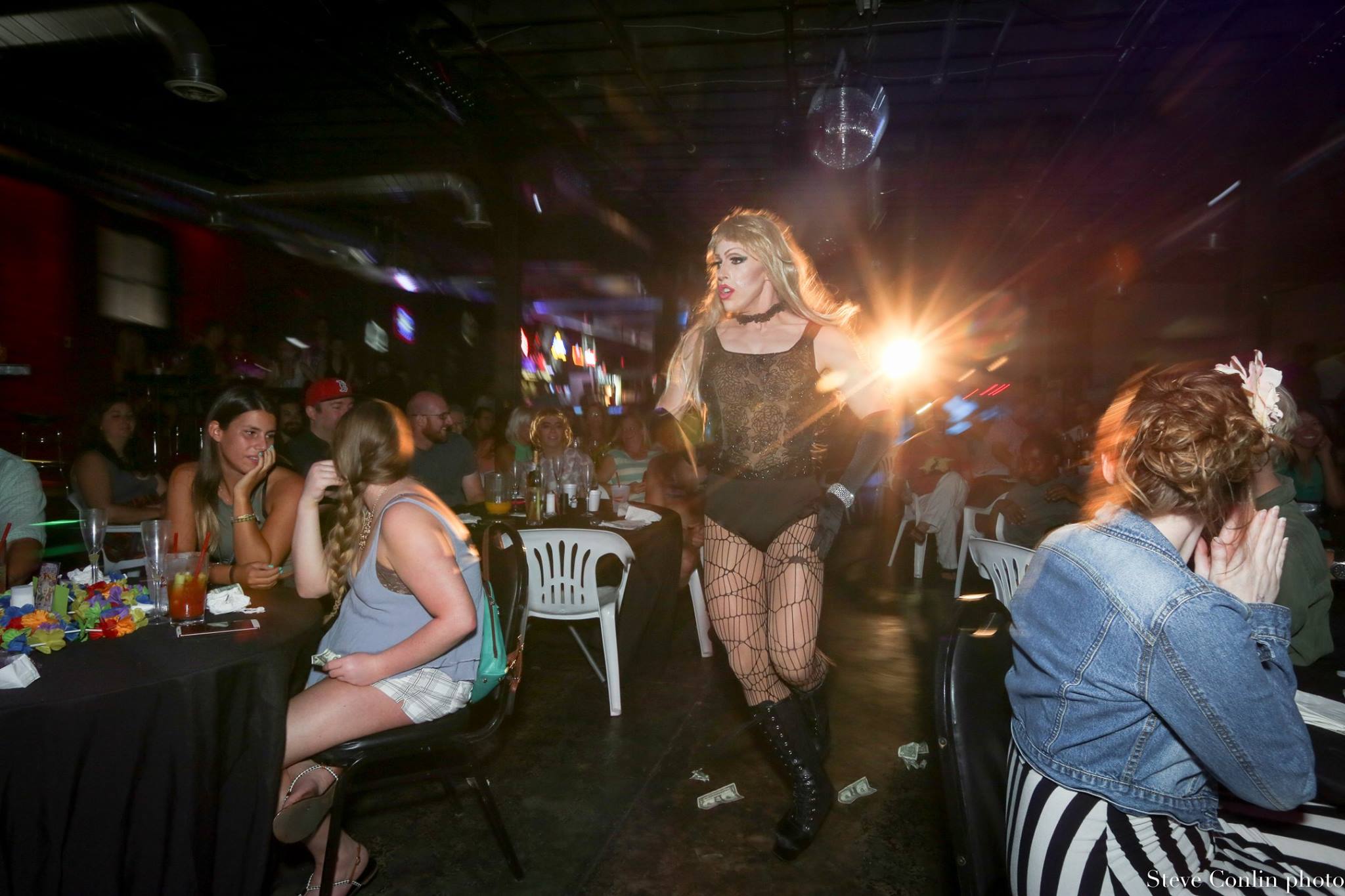
Read about Davis's "Dragging Gender into the 21st Century" class here. Photos courtesy of Shane Davis. Photo credits: Anna Day @moabchica, Steve Conlin @steve_conlin_photo, and Gilbert Garcia @instaguygil
Interested in contributing to this series? Contact Noelle Sharp.
The University of Utah Department of Theatre closes the 2017-18 season with The Two Noble Kinsmen at the Babcock Theatre 4/7 – 4/15. As one of 39 plays to be translated into modern English for the Oregon Shakespeare Festival’s Play On! Project, this play was translated by Professor Tim Slover with production dramaturgy from Alex Vermillion and Play On! Project dramaturgy from Assistant Professor Martine Kei Green-Rogers. The production is directed by College of Fine Arts Distinguished Alum Randy Reyes, with Artistic Director Bill Rauch and Executive Director Cynthia Rider.
The themes of The Two Noble Kinsmen are universal—love, honor, respect—but in the world of our protagonists, Arcite and Palamon, these ideas come at a much higher cost than for the average modern US citizen. “The world these cousins live in is one of turmoil, it’s war-torn, blood-drenched, and controlled by the gods. And yet, The Two Noble Kinsmen reminds us that even in the darkest of times, there are moments of humor, gentleness, and celebration,” said Vermillion.
MU Performing Arts Artistic Director Randy Reyes has created a world inspired by ancient Greece, the Blackfriars’ stage, war, “The Hunger Games,” hip-hop culture, and high fashion. “By combining all these elements we are creating a unique world reflective of the past (Shakespeare’s original inspirations), the present (Slover’s translation), and the future (with the next generation of Shakespearean actors),” said Reyes. The translation celebrates Shakespeare’s masterwork by focusing directly on translating the antiquated language to increase understanding, while maintaining the vibrancy of the original.
The Department of Theatre’s production of The Two Noble Kinsmen hopes to reach Shakespeare fanatics and make Shakespeare more accessible and inclusive to audiences who have little to no experience with his work.
About the Play On! Project: Oregon Shakespeare Festival commissioned 36 playwrights and paired them with dramaturgs to translate 39 plays attributed to Shakespeare into contemporary modern English. By seeking out a diverse set of playwrights (more than half writers of color and more than half women), they hope to bring fresh voices and perspectives to the rigorous work of translation. Each playwright is being asked to put the same pressure and rigor of language as Shakespeare did on his, keeping in mind meter, rhythm, metaphor, image, rhyme, rhetoric and emotional content. By the end there will be 39 unique side-by-side companion translations of Shakespeare’s plays that are both performable and extremely useful reference texts for both classrooms and productions.
Join us for a post production “Shakespeare Translation Discussion” with Dr.Lou Douthit on 4/7. Dr. Lue Morgan Douthit is the Director of Play on! 36 playwrights translate Shakespeare, the post-show discussion will include the highly debated topic of translating Shakespeare and the impact that Play on! is achieving through making Shakespeare more accessible and inclusive. Other members of the post-show discussion will include The Two Noble Kinsmen Director, Randy Reyes and Assistant Director for Play on!, Taylor Bailey. Reyes is an alumni of the University of Utah Actor Training Program who received a College of Fine Arts Distinguished Alumni Award in 2016 and graduated from The Juilliard School Drama Division in 1999. He is currently Mu Performing Art’s Artistic Director.
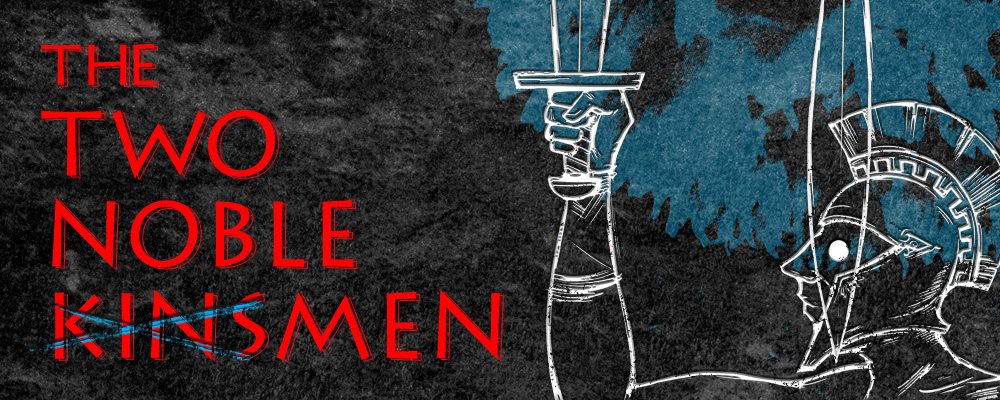
Two Noble Kinsmen runs 4/7- 4/9 and 4/13- 4/15 at 7:30PM with a matinee at 4/15 at 2PM. Located in The Babcock Theatre, located at 300 South and University Street (1400 East) in the Simmons Pioneer Memorial Theatre, lower level. Free parking is available to the south of the theatre and at Rice Eccles Stadium.
Post-Performance Discussion is on 4/7 with Randy Reyes, Director; Dr. Lue Douthit, Play On! Director; and Taylor Bailey, Assistant Director of Play On! and the Post-Performance Panel on 4/14 with Dr. Ann Engar, Professor of Intellectual Traditions and the Honors College; Dr. Richard Preiss, Associate Professor of English; and Dr. Disa Gambera, Associate Professor of English.
General Admission tickets are $18, University of Utah faculty and staff are $15, U of U students are free with UCard and all other students with valid student ID are $8.50. Tickets can be obtained by calling 801-581-7100, online or at the Performing Arts Box Office, located at Kingsbury Hall.
This February, the School of Dance at the University of Utah is honored to welcome Gino Grenek of the Stephen Petronio Company for an exciting residency with dancers from both the Modern Dance and Ballet programs. Grenek's work with the company spans over 17 years, and he will work with the dancers to reset Petronio’s seminal work, MiddleSexGorge. This will be the first time the work has ever been performed by a university, and the school is alive with anticipation of this powerful part of the Gala program.
The inclusion of work in the Gala by the groundbreaking company, which celebrated its 30th anniversary just a few years ago, is a wonderful way to celebrate our start as the new School of Dance. It is without question an incredible honor for our students to have the opportunity to perform Petronio’s MiddleSexGorge.
Since founding SPC in 1984, Petronio has created over 35 works for his company and has been commissioned by some of the world’s most prestigious modern and ballet companies, including William Forsythe’s Ballett Frankfurt (1987), Deutsche Oper Berlin (1992), Lyon Opera Ballet (1994), Maggio Danza Florence (1996), Sydney Dance Company (2003, full evening), Norrdans (2006), the Washington Ballet (2007), The Scottish Ballet (2007), and two works for National Dance Company Wales (2010 and 2013).
His career has been greatly influenced by his work with Steve Paxton, as well as his time with the Trisha Brown Dance Company (1979 to 1986), of which he was the first male dancer. He has gone on to build a unique career, receiving numerous accolades, including a John Simon Guggenheim Fellowship, awards from the Foundation for Contemporary Performance Arts, New York Foundation for the Arts, an American Choreographer Award, a New York Dance and Performance “Bessie” Award, and most recently a 2015 Doris Duke Performing Artist Award.
Stephen Petronio Company is now working on an unprecedented program, Bloodlines, which will honor a lineage of postmodern dance-masters. Over the course of 5 years SPC will perform choreography from influential artists along with creations by Petronio. Dedicated to the concept of artistic lineage, SPC will be the first contemporary American company to perform these iconic works outside of their original choreographer’s companies.
The School of Dance is thrilled for this unique engagement with the Stephen Petronio Company and looks forward to sharing this exciting program with the Salt Lake community.
Please join us for the School of Dance Gala on 3/23 – 4/1 at the Marriott Center for Dance.
Lassonde's "Coffee with Creatives" series will feature CFA Creatives
Coffee with Creatives is a monthly series hosted by the Arts Entrepreneurship program at Lassonde Studios that brings creative professionals from all around to speak to students about how they have succeeded in the creative industry professionally, or how their arts background plays into their work.
This falls in line with the Arts Entrepreneurship goals to provide programming that sits at the intersection of arts and industry. We want to teach creatives about all the opportunities they have ahead of them, and teach entrepreneurs how to endow more creative spirit in their work. So for those looking for a jolt of inspiration with their morning coffee, Coffee with Creatives is the way to go.
Coffee with Creatives dates:
- Film and Media Arts Professors, Sonia and Mirriam Sobrino, on 2/24 at 10AM located in the Neeleman-hangar
- Assistant Dean for Art & Creative Engagement, ED of UtahPresents, Brooke Horejsi, on 3/23 at 10AM in Lassonde Studios.

